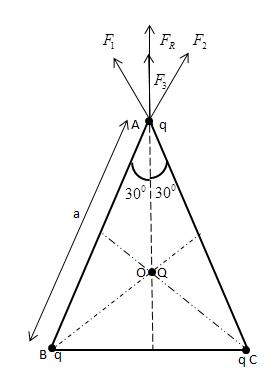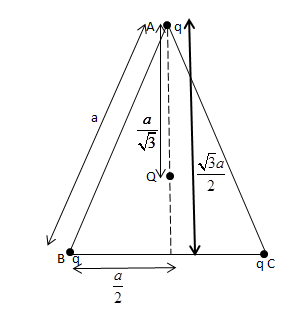Question
Question: Three charges each of value q are placed at the corners of an equilateral triangle. A fourth charge ...
Three charges each of value q are placed at the corners of an equilateral triangle. A fourth charge Q is placed at the center of the triangle.
A. If Q= - q, will the charges at the corners move toward the center or fly away from it
B. For what value of Q at 0 will the charges remain stationary?
Solution
Hint: Since this is an equilateral triangle the angles as well as the length of the sides will be equal. When we place a charge Q at the center of the triangle, the impact on all the other charges kept at the vertex, since equidistant, will be the same. The net resultant force acting on all the vertices of A, B, C of the equilateral triangle will be the sum of the forces due to the charge on other two vertices and the charge at the center.
Formula used:
F=4πε01r2q1q2(Coulomb’s Law), Fis the electrical force between two charged objects, q1 represents the quantity of charge on object 1 (in Coulombs),q2 represents the quantity of charge on object 2 (in Coulombs), and r represents the distance of separation between the two objects (in meters) and ε0 is the vacuum permittivity, permittivity of free space.
Complete step by step answer:
Three charges of equal magnitude are placed at the vertices of an equilateral triangle with side length a. First we can find the force along the direction of OA. Let the force due to charge q on vertex B be F1 and due to charge q on vertex C be F2. Using F=4πε01r2q1q2(Coulomb’s Law), where F is the electrical force between two charged objects, q1 represents the quantity of charge on object 1 (in Coulombs), q2 represents the quantity of charge on object 2 (in Coulombs), and r represents the distance of separation between the two objects (in meters) and ε0 is the vacuum permittivity, permittivity of free space. We get,
F1=4πε01a2q2cos(300) along OA
F2=4πε01a2q2cos(300) along OA
When we place a charge Q at the center O, the force experienced along OA is
F3=4πε01(3a)2Qq
The resultant force FR will be F1+F2+F3 since all the forces are taken along the OA direction.
FR=F1+F2+F3
FR=4πε01a2q2cos(300)+4πε01a2q2cos(300)+4πε01(3a)2Qq
FR=4πε01a2q[3q+3Q]

A) Using Q = - q in equationFR=4πε01a2q[3q+3Q], we get
FR=4πε01a2q[3q−3q]along OA
FR=4πε01a23q2[1−3]along OA
FR=4πε01a23q2[3−1]along AO
B) Charge will remain stationary if FR = 0
For FR=4πε01a2q[3q+3Q]=0
[3q+3Q]=0
Q=3−q
If Q=3−q, the charges will remain stationary.
Note: Using Pythagoras theorem the length of the altitude of the triangle can be found to be 23a. Remember that the angle bisector of an equilateral triangle will bisect the opposite side. For an equilateral triangle the center O divides the altitude (since the triangle is equilateral, the length of perpendicular from any vertex will be the same.) in the ratio 2:1Therefore the length OA will be two by third of the total length.
OA=32×23a=3a

